Case Study and IT Research: Key Reasons for IT Implementation Failure
VerifiedAdded on 2023/06/08
|8
|1219
|192
AI Summary
This case study discusses the key reasons for IT implementation failure, the responsible party, and recommendations for fixing the current problems. It also outlines successful IT implementation stories in hospitals/health departments.
Contribute Materials
Your contribution can guide someone’s learning journey. Share your
documents today.

Running Head: CASE STUDY 1
Assignment 3: Case study and IT Research
Student name
Course
Affiliation/University
Assignment 3: Case study and IT Research
Student name
Course
Affiliation/University
Secure Best Marks with AI Grader
Need help grading? Try our AI Grader for instant feedback on your assignments.
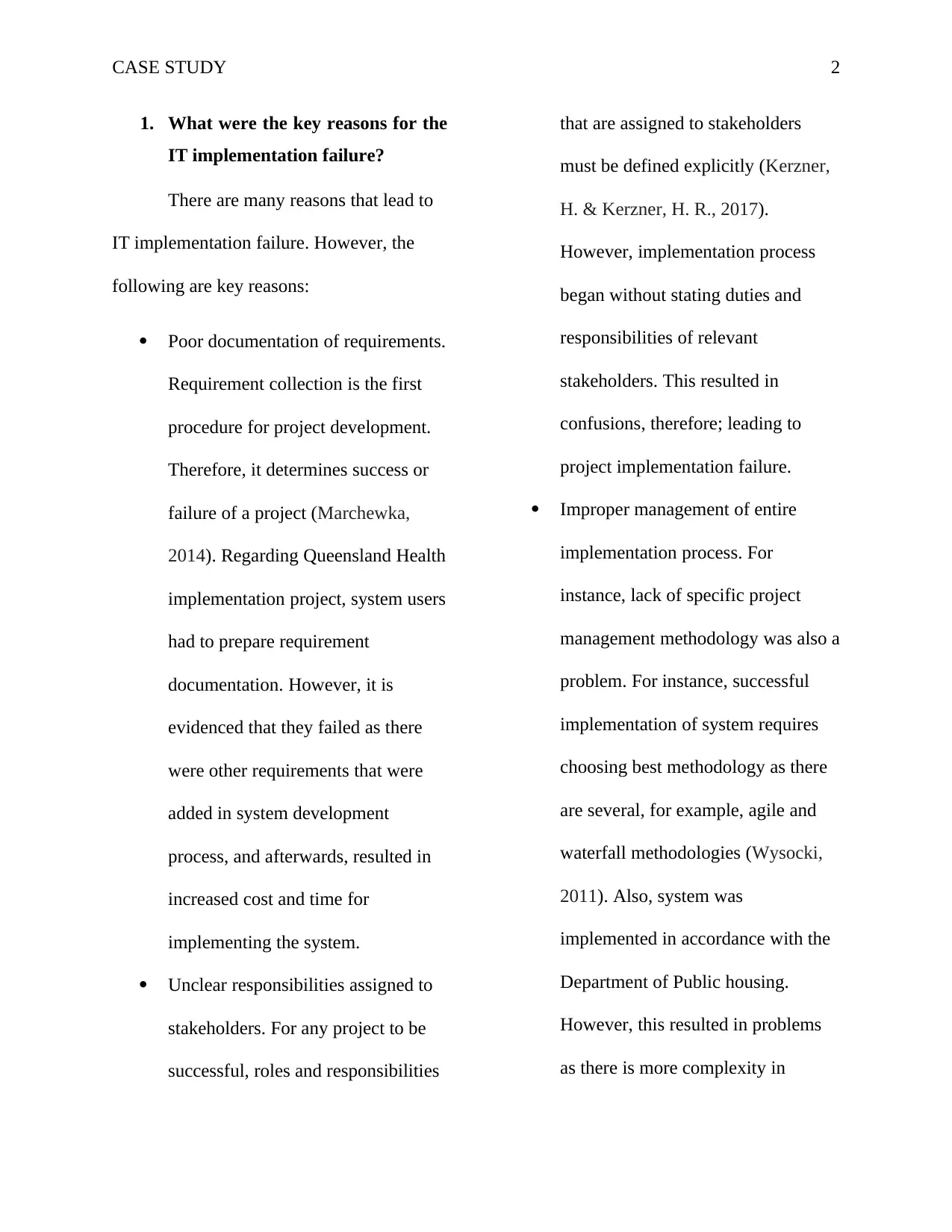
CASE STUDY 2
1. What were the key reasons for the
IT implementation failure?
There are many reasons that lead to
IT implementation failure. However, the
following are key reasons:
Poor documentation of requirements.
Requirement collection is the first
procedure for project development.
Therefore, it determines success or
failure of a project (Marchewka,
2014). Regarding Queensland Health
implementation project, system users
had to prepare requirement
documentation. However, it is
evidenced that they failed as there
were other requirements that were
added in system development
process, and afterwards, resulted in
increased cost and time for
implementing the system.
Unclear responsibilities assigned to
stakeholders. For any project to be
successful, roles and responsibilities
that are assigned to stakeholders
must be defined explicitly (Kerzner,
H. & Kerzner, H. R., 2017).
However, implementation process
began without stating duties and
responsibilities of relevant
stakeholders. This resulted in
confusions, therefore; leading to
project implementation failure.
Improper management of entire
implementation process. For
instance, lack of specific project
management methodology was also a
problem. For instance, successful
implementation of system requires
choosing best methodology as there
are several, for example, agile and
waterfall methodologies (Wysocki,
2011). Also, system was
implemented in accordance with the
Department of Public housing.
However, this resulted in problems
as there is more complexity in
1. What were the key reasons for the
IT implementation failure?
There are many reasons that lead to
IT implementation failure. However, the
following are key reasons:
Poor documentation of requirements.
Requirement collection is the first
procedure for project development.
Therefore, it determines success or
failure of a project (Marchewka,
2014). Regarding Queensland Health
implementation project, system users
had to prepare requirement
documentation. However, it is
evidenced that they failed as there
were other requirements that were
added in system development
process, and afterwards, resulted in
increased cost and time for
implementing the system.
Unclear responsibilities assigned to
stakeholders. For any project to be
successful, roles and responsibilities
that are assigned to stakeholders
must be defined explicitly (Kerzner,
H. & Kerzner, H. R., 2017).
However, implementation process
began without stating duties and
responsibilities of relevant
stakeholders. This resulted in
confusions, therefore; leading to
project implementation failure.
Improper management of entire
implementation process. For
instance, lack of specific project
management methodology was also a
problem. For instance, successful
implementation of system requires
choosing best methodology as there
are several, for example, agile and
waterfall methodologies (Wysocki,
2011). Also, system was
implemented in accordance with the
Department of Public housing.
However, this resulted in problems
as there is more complexity in
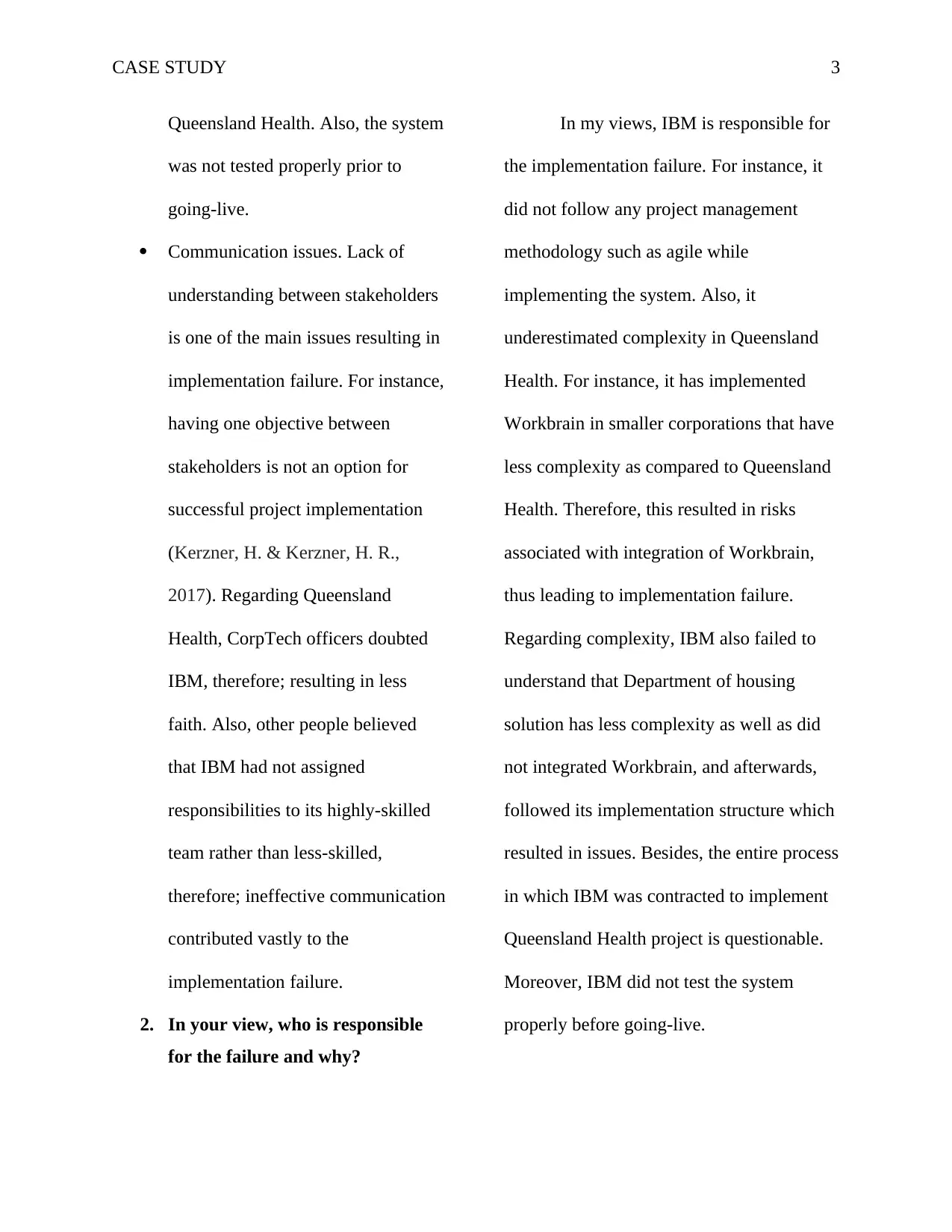
CASE STUDY 3
Queensland Health. Also, the system
was not tested properly prior to
going-live.
Communication issues. Lack of
understanding between stakeholders
is one of the main issues resulting in
implementation failure. For instance,
having one objective between
stakeholders is not an option for
successful project implementation
(Kerzner, H. & Kerzner, H. R.,
2017). Regarding Queensland
Health, CorpTech officers doubted
IBM, therefore; resulting in less
faith. Also, other people believed
that IBM had not assigned
responsibilities to its highly-skilled
team rather than less-skilled,
therefore; ineffective communication
contributed vastly to the
implementation failure.
2. In your view, who is responsible
for the failure and why?
In my views, IBM is responsible for
the implementation failure. For instance, it
did not follow any project management
methodology such as agile while
implementing the system. Also, it
underestimated complexity in Queensland
Health. For instance, it has implemented
Workbrain in smaller corporations that have
less complexity as compared to Queensland
Health. Therefore, this resulted in risks
associated with integration of Workbrain,
thus leading to implementation failure.
Regarding complexity, IBM also failed to
understand that Department of housing
solution has less complexity as well as did
not integrated Workbrain, and afterwards,
followed its implementation structure which
resulted in issues. Besides, the entire process
in which IBM was contracted to implement
Queensland Health project is questionable.
Moreover, IBM did not test the system
properly before going-live.
Queensland Health. Also, the system
was not tested properly prior to
going-live.
Communication issues. Lack of
understanding between stakeholders
is one of the main issues resulting in
implementation failure. For instance,
having one objective between
stakeholders is not an option for
successful project implementation
(Kerzner, H. & Kerzner, H. R.,
2017). Regarding Queensland
Health, CorpTech officers doubted
IBM, therefore; resulting in less
faith. Also, other people believed
that IBM had not assigned
responsibilities to its highly-skilled
team rather than less-skilled,
therefore; ineffective communication
contributed vastly to the
implementation failure.
2. In your view, who is responsible
for the failure and why?
In my views, IBM is responsible for
the implementation failure. For instance, it
did not follow any project management
methodology such as agile while
implementing the system. Also, it
underestimated complexity in Queensland
Health. For instance, it has implemented
Workbrain in smaller corporations that have
less complexity as compared to Queensland
Health. Therefore, this resulted in risks
associated with integration of Workbrain,
thus leading to implementation failure.
Regarding complexity, IBM also failed to
understand that Department of housing
solution has less complexity as well as did
not integrated Workbrain, and afterwards,
followed its implementation structure which
resulted in issues. Besides, the entire process
in which IBM was contracted to implement
Queensland Health project is questionable.
Moreover, IBM did not test the system
properly before going-live.
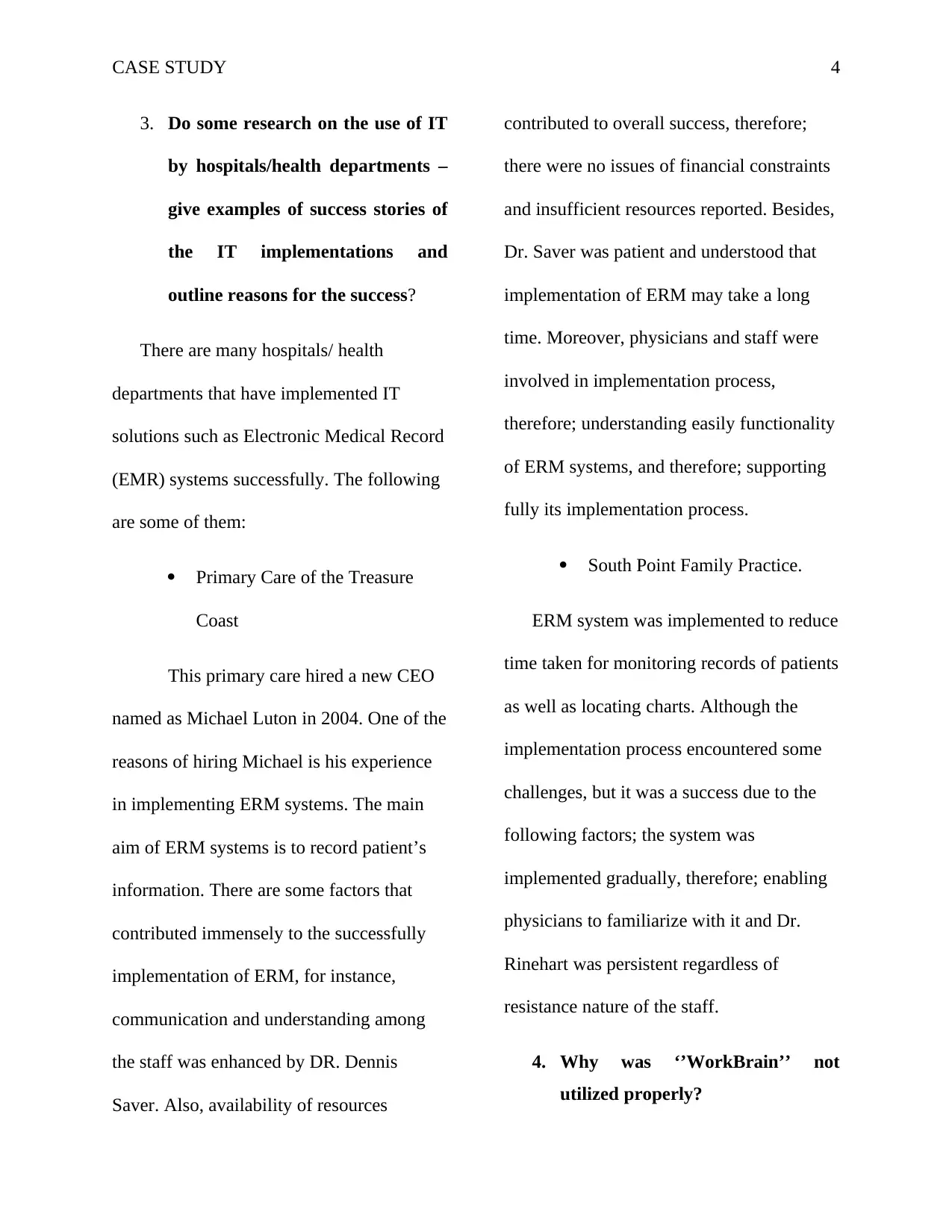
CASE STUDY 4
3. Do some research on the use of IT
by hospitals/health departments –
give examples of success stories of
the IT implementations and
outline reasons for the success?
There are many hospitals/ health
departments that have implemented IT
solutions such as Electronic Medical Record
(EMR) systems successfully. The following
are some of them:
Primary Care of the Treasure
Coast
This primary care hired a new CEO
named as Michael Luton in 2004. One of the
reasons of hiring Michael is his experience
in implementing ERM systems. The main
aim of ERM systems is to record patient’s
information. There are some factors that
contributed immensely to the successfully
implementation of ERM, for instance,
communication and understanding among
the staff was enhanced by DR. Dennis
Saver. Also, availability of resources
contributed to overall success, therefore;
there were no issues of financial constraints
and insufficient resources reported. Besides,
Dr. Saver was patient and understood that
implementation of ERM may take a long
time. Moreover, physicians and staff were
involved in implementation process,
therefore; understanding easily functionality
of ERM systems, and therefore; supporting
fully its implementation process.
South Point Family Practice.
ERM system was implemented to reduce
time taken for monitoring records of patients
as well as locating charts. Although the
implementation process encountered some
challenges, but it was a success due to the
following factors; the system was
implemented gradually, therefore; enabling
physicians to familiarize with it and Dr.
Rinehart was persistent regardless of
resistance nature of the staff.
4. Why was ‘’WorkBrain’’ not
utilized properly?
3. Do some research on the use of IT
by hospitals/health departments –
give examples of success stories of
the IT implementations and
outline reasons for the success?
There are many hospitals/ health
departments that have implemented IT
solutions such as Electronic Medical Record
(EMR) systems successfully. The following
are some of them:
Primary Care of the Treasure
Coast
This primary care hired a new CEO
named as Michael Luton in 2004. One of the
reasons of hiring Michael is his experience
in implementing ERM systems. The main
aim of ERM systems is to record patient’s
information. There are some factors that
contributed immensely to the successfully
implementation of ERM, for instance,
communication and understanding among
the staff was enhanced by DR. Dennis
Saver. Also, availability of resources
contributed to overall success, therefore;
there were no issues of financial constraints
and insufficient resources reported. Besides,
Dr. Saver was patient and understood that
implementation of ERM may take a long
time. Moreover, physicians and staff were
involved in implementation process,
therefore; understanding easily functionality
of ERM systems, and therefore; supporting
fully its implementation process.
South Point Family Practice.
ERM system was implemented to reduce
time taken for monitoring records of patients
as well as locating charts. Although the
implementation process encountered some
challenges, but it was a success due to the
following factors; the system was
implemented gradually, therefore; enabling
physicians to familiarize with it and Dr.
Rinehart was persistent regardless of
resistance nature of the staff.
4. Why was ‘’WorkBrain’’ not
utilized properly?
Secure Best Marks with AI Grader
Need help grading? Try our AI Grader for instant feedback on your assignments.
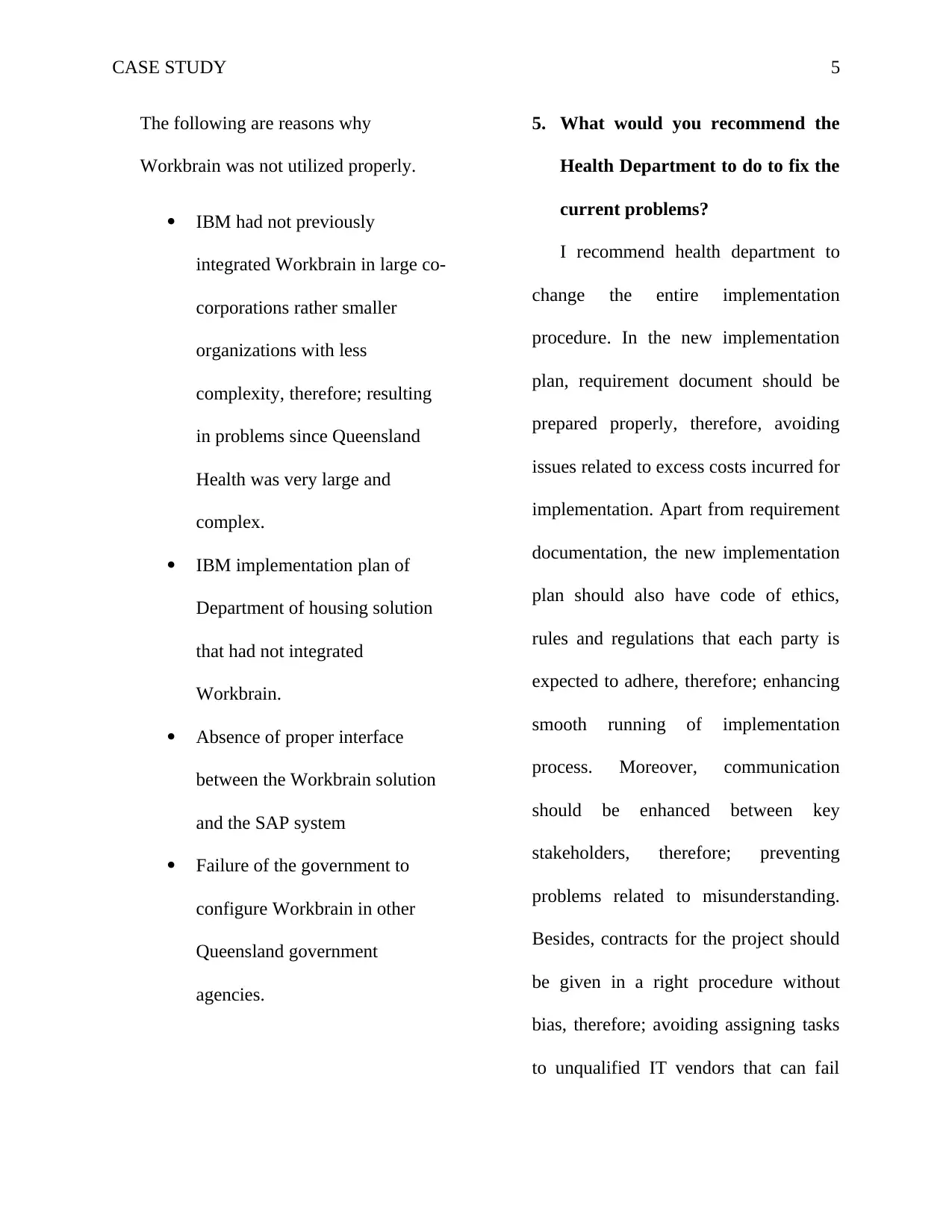
CASE STUDY 5
The following are reasons why
Workbrain was not utilized properly.
IBM had not previously
integrated Workbrain in large co-
corporations rather smaller
organizations with less
complexity, therefore; resulting
in problems since Queensland
Health was very large and
complex.
IBM implementation plan of
Department of housing solution
that had not integrated
Workbrain.
Absence of proper interface
between the Workbrain solution
and the SAP system
Failure of the government to
configure Workbrain in other
Queensland government
agencies.
5. What would you recommend the
Health Department to do to fix the
current problems?
I recommend health department to
change the entire implementation
procedure. In the new implementation
plan, requirement document should be
prepared properly, therefore, avoiding
issues related to excess costs incurred for
implementation. Apart from requirement
documentation, the new implementation
plan should also have code of ethics,
rules and regulations that each party is
expected to adhere, therefore; enhancing
smooth running of implementation
process. Moreover, communication
should be enhanced between key
stakeholders, therefore; preventing
problems related to misunderstanding.
Besides, contracts for the project should
be given in a right procedure without
bias, therefore; avoiding assigning tasks
to unqualified IT vendors that can fail
The following are reasons why
Workbrain was not utilized properly.
IBM had not previously
integrated Workbrain in large co-
corporations rather smaller
organizations with less
complexity, therefore; resulting
in problems since Queensland
Health was very large and
complex.
IBM implementation plan of
Department of housing solution
that had not integrated
Workbrain.
Absence of proper interface
between the Workbrain solution
and the SAP system
Failure of the government to
configure Workbrain in other
Queensland government
agencies.
5. What would you recommend the
Health Department to do to fix the
current problems?
I recommend health department to
change the entire implementation
procedure. In the new implementation
plan, requirement document should be
prepared properly, therefore, avoiding
issues related to excess costs incurred for
implementation. Apart from requirement
documentation, the new implementation
plan should also have code of ethics,
rules and regulations that each party is
expected to adhere, therefore; enhancing
smooth running of implementation
process. Moreover, communication
should be enhanced between key
stakeholders, therefore; preventing
problems related to misunderstanding.
Besides, contracts for the project should
be given in a right procedure without
bias, therefore; avoiding assigning tasks
to unqualified IT vendors that can fail
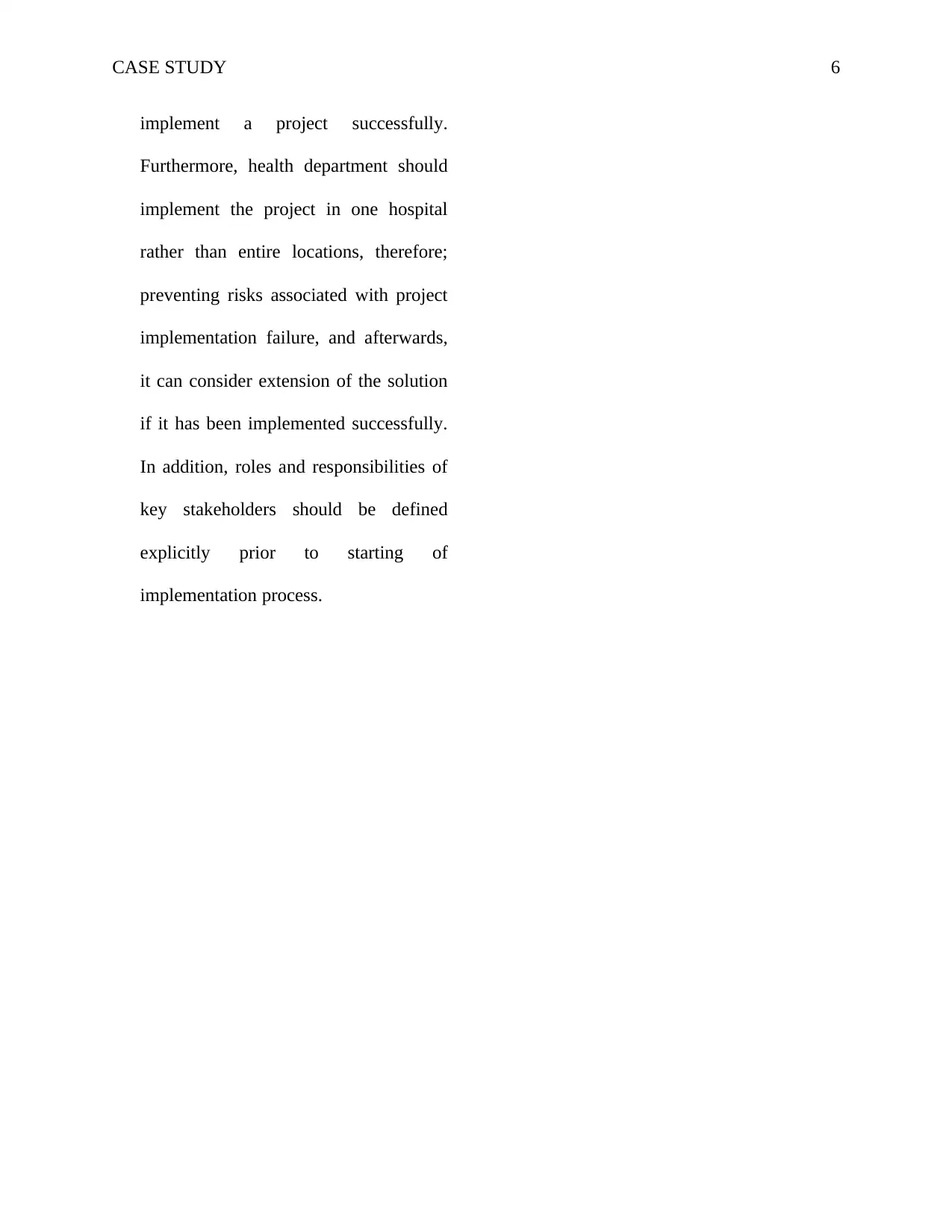
CASE STUDY 6
implement a project successfully.
Furthermore, health department should
implement the project in one hospital
rather than entire locations, therefore;
preventing risks associated with project
implementation failure, and afterwards,
it can consider extension of the solution
if it has been implemented successfully.
In addition, roles and responsibilities of
key stakeholders should be defined
explicitly prior to starting of
implementation process.
implement a project successfully.
Furthermore, health department should
implement the project in one hospital
rather than entire locations, therefore;
preventing risks associated with project
implementation failure, and afterwards,
it can consider extension of the solution
if it has been implemented successfully.
In addition, roles and responsibilities of
key stakeholders should be defined
explicitly prior to starting of
implementation process.
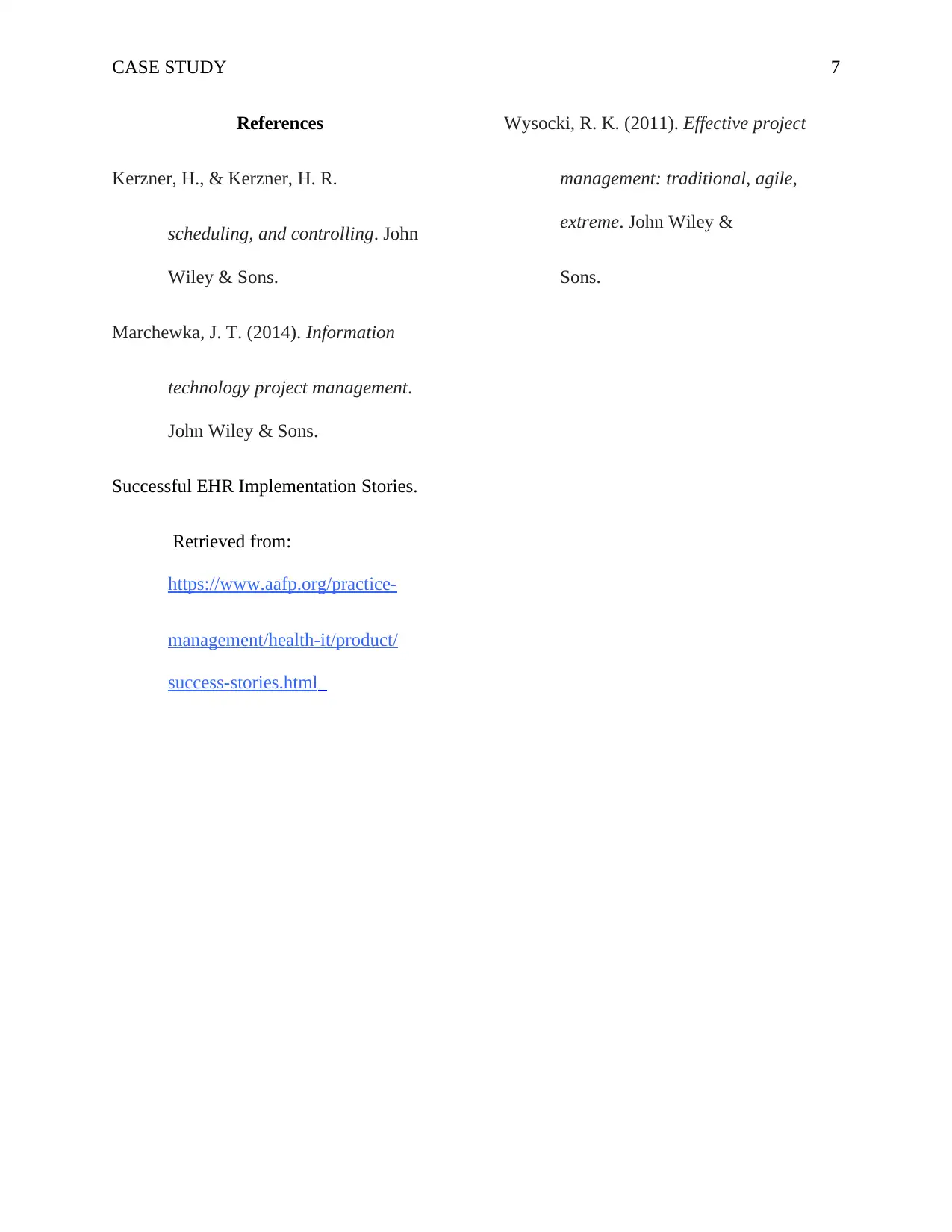
CASE STUDY 7
References
Kerzner, H., & Kerzner, H. R.
scheduling, and controlling. John
Wiley & Sons.
Marchewka, J. T. (2014). Information
technology project management.
John Wiley & Sons.
Successful EHR Implementation Stories.
Retrieved from:
https://www.aafp.org/practice-
management/health-it/product/
success-stories.html
Wysocki, R. K. (2011). Effective project
management: traditional, agile,
extreme. John Wiley &
Sons.
References
Kerzner, H., & Kerzner, H. R.
scheduling, and controlling. John
Wiley & Sons.
Marchewka, J. T. (2014). Information
technology project management.
John Wiley & Sons.
Successful EHR Implementation Stories.
Retrieved from:
https://www.aafp.org/practice-
management/health-it/product/
success-stories.html
Wysocki, R. K. (2011). Effective project
management: traditional, agile,
extreme. John Wiley &
Sons.
Paraphrase This Document
Need a fresh take? Get an instant paraphrase of this document with our AI Paraphraser

CASE STUDY 8
1 out of 8
Related Documents
Your All-in-One AI-Powered Toolkit for Academic Success.
+13062052269
info@desklib.com
Available 24*7 on WhatsApp / Email
![[object Object]](/_next/static/media/star-bottom.7253800d.svg)
Unlock your academic potential
© 2024 | Zucol Services PVT LTD | All rights reserved.





